

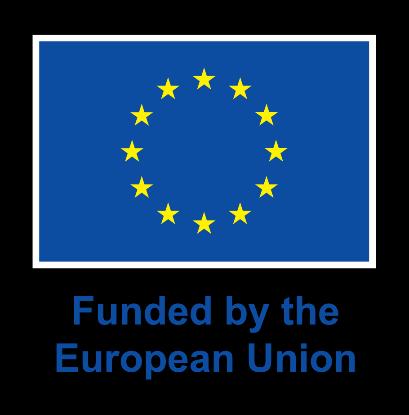
ERASMUS+, KEY ACTION 2, REG.NUMBER 2022-1-BG01-KA220-SCH-000086879 PARTNERSHIP PROJECT BETWEEN BULGARIA, FINLAND, AUSTRIA and TÜRKIYE METHODOLOGY FOR USING STEAM APPROACH WITH CONSTRUCTIVE ACTIVITIES LegoDuploSteam.eu 2024
The STEAM approach (Science, Technology, Engineering, Art and Mathematics) to construction activities using LEGO DUPLO materials in kindergarten has the following major methodological
This methodology has been developed in the framework of the Erasmus+ project "Kids build their knowledge and skills about the world through STEAM", KA 2 with registration number 2022-1-BG01-KA220-SCH-000086879. No part of it may be used without quoting the authors of the methodology and the project. Co-funded by the European Union. However, the views and opinions expressed are entirely those of the author(s) and do not necessarily reflect those of the European Union or the European Education and Culture Executive Agency (EACEA). Neither the European Union nor the EACEA is responsible for them.
About the project:
Four kindergartens are participating in the project: DG 184 "Mecho Pooh" (Sofia, Bulgaria), DG 65 "Sunny Childhood" (Sofia, Bulgaria), Kindergarten Korento (Helsinki, Finland), Kindergarten Ozel Akdeniz Basari Anaokulu (Manavgat, Turkey ) and four training organizations: DZZD "Education" (Ruse, Bulgaria), T-oppi OY (Espoo, Finland), Epsilon Marketing e.U (Vienna, Austria), Europe Route Education Youth Sports and Culture Association (Manavgat, Turkey). It is implemented in the period from September 1, 2022 to July 31, 2024. All methodological units have been approved and evaluated for applicability in the kindergartens of the project partner countries.
2 CONTENT
components: Science, engineering and technology...................................................................3 Pedagogical framework........................................................................................4 Learning objectives...............................................................................................6 Interdisciplinary aspects 7 Learning materials................................................................................................9 Assessment strategies ........................................................................................12 Teacher training..................................................................................................14 List of resources..................................................................................................16 Working conditions and safety...........................................................................20
Science, engineering and technology
DEFINITIONS
Engineering
The creative application of scientific principles:
• to design or develop structures, machines, apparatus, or manufacturing processes, or works utilizing them singly or in combination;
• to construct or operate the same with full cognizance of their design;
• to forecast their behavior under specific operating conditions. All as respects an intended function, economics of operation and safety to life and property.
Technology
In the 20th century, as a result of scientific progress and the Second Industrial Revolution, technology stopped being considered a distinct academic discipline and took on its currentday meaning: the systemic use of knowledge to practical ends.
RELATION TO SCIENCE AND ENGINEERING
Engineering is the process by which technology is developed. It often requires problem-solving under strict constraints. Technological development is "action-oriented", while scientific knowledge is fundamentally explanatory. Polish philosopher Henryk Skolimowski framed it like so: "science concerns itself with what is, technology with what is to be."
The direction of causality between scientific discovery and technological innovation has been debated by scientists, philosophers and policymakers. Because innovation is often undertaken at the edge of scientific knowledge, most technologies are not derived from scientific knowledge, but instead from engineering, tinkering and chance. For example, in the 1940s and 1950s, when knowledge of turbulent combustion or fluid dynamics was still crude, jet engines were invented through "running the device to destruction, analyzing what broke [...] and repeating the process". Scientific explanations often follow technological developments rather than preceding them. Many discoveries also arose from pure chance, like the discovery of penicillin as a result of accidental lab contamination.
Since the 1960s, the assumption that government funding of basic research would lead to the discovery of marketable technologies has lost credibility. American economist and philosopher Nassim Taleb argues that national research programs based on frequent trial and error are more likely to lead to useful innovations than research that aims to reach specific outcomes.
CONCLUSION
The “technology” aspect of STEAM in the context of this project is that the technology chosen for the project is LEGO Duplo. This is engineered in different ways to produce desired outcomes.
3
Pedagogical framework
This section describes how the STEAM approach conforms to the principles of preschool education. The hands-on learning and inquiry approach that underpins STEAM learning supports cognitive development, creativity, problem-solving and social skills in young children. By combining science, technology, engineering, art and mathematics, children develop both analytical and creative abilities while acquiring interdisciplinary thinking skills.
The STEAM approach provides the following opportunities:
1. Overall development of the child's personality
This is due to the variety of activities that take place in STEAM learning, as they activate multiple areas of the brain:
• Frontal Lobe: Responsible for planning, problem solving and decision making. The STEAM approach encourages critical thinking and problem solving, which engages this area of the brain
• Parietal Lobe: Plays an important role in processing sensory information from different parts of the body, as well as in navigation and understanding mathematical and spatial concepts. The STEAM approach, especially through mathematics and engineering, stimulates this region
• Occipital Lobe: Involved in visual perception and interpretation, which is particularly important in art and the visual aspects of science and engineering. Activities that require pattern recognition and visual art engage the parietal lobe.
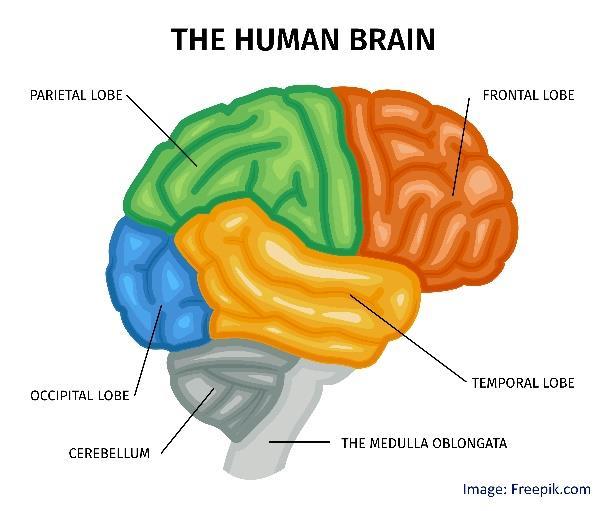
• Limbic system: Responsible for emotions and memory. The art and creative aspects of STEAM engage this system, helping to connect emotionally with the learning material and enhance retention
• Cerebellum and basal ganglia: Involved in movement coordination and fine motor skills. Activities related to practical project work and experiments engage these areas. The projects that children work on using the STEAM approach are selected to promote their cognitive, physical, social and emotional development. In this way, they are encouraged to use all their senses and apply a variety of different skills, which supports their harmonious development.
2.
Learning through play
Preschool education strongly emphasizes the important place of play in the learning process. Activities within the STEAM approach are designed as interesting and engaging tasks that allow children to experiment, explore and discover new concepts in an engaging and meaningful way, reflecting the philosophy of learning through play.
3. Development of research skills
The STEAM approach and principles of preschool education value an inquiry approach to learning where children are encouraged to ask questions, hypothesize, experiment and
4
explore to reach specific outcomes and conclusions. This approach nurtures curiosity and a love of learning, allowing children to follow their interests and learn through discovery. It follows 6 basic steps:
4. Creativity and imagination
STEAM integrates the arts with science, technology, engineering and mathematics in a way that fosters creativity and imagination. This is consistent with an emphasis in early childhood education that sees creative expression as a fundamental aspect of learning and development.
5. Problem solving and critical thinking
Preschool education promotes the development of problem-solving skills and critical thinking from an early age. STEAM presents children with challenges related to solving real problems, requiring them to think critically, try out options, detect errors, and look for solutions.
6. Social and emotional development
Most STEAM projects promote teamwork, communication and social skills. By working together, children develop empathy, see different points of view, share, discuss and build relationships of partnership and cooperation, which are key components of preschool education.
7. Connection to the real world
In STEAM, the approach is based on the application of knowledge and skills in real situations, making learning relevant and engaging. This approach helps children make connections between what they are learning and the world around them. This principle is embedded in preschool education, which values contextual and meaningful learning experiences.
8. Adaptability and flexibility
Preschool education accommodates and respects the diverse learning styles and pace of young children. The STEAM approach is adaptable and can be customized to meet the specific needs and interests of the individual child, providing a tailored learning environment.
By integrating STEAM into the preschool education system, teachers can create a rich and dynamic learning environment that fosters children's natural curiosity, encourages active learning, and develops the critical thinking and problem-solving skills they will need in the future. In this way, the development of some of the key competences for lifelong learning laid down in the European Reference Framework is also supported.
5
CONCLUSION ANALYSIS EXPERIMENT HYPOTHESIS QUESTIONS OBSERVATION
Learning objectives
This section describes learning objectives within the methodology in terms of the five STEAM areas.
Learning objectives focus on introducing some basic concepts in science, basic engineering principles, introduction to mathematical concepts, technology awareness and creative expression through the arts.
The learning units developed have age-appropriate and achievable learning objectives for each area of STEAM using LEGO DUPLO:
SCIENCE
- Objective: To familiarize children with basic scientific concepts such as weight, balance, speed, distance, symmetry, light and shadow, life cycle, living conditions, etc., as well as to discover and investigate cause-and-effect relationships between objects, phenomena and/or processes
- Learning units: C-2; C-3; C-4; D-1; D-2; D-3; D-4; D-5; H-1; H-2.
TECHNOLOGIES
- Objective: For children to develop an understanding of simple devices, mechanisms and equipment and how they can be used to solve problem.
- Learning units: Е-1; Е-2; Е-3; F-1; F-2; F-3; F-4; G-1; G-2; G-3; H-1; H-2; I-1; I-2; I-3; I-4; I-5; I-6; I-7; I-8; I-9
ENGINEERING
- Objective: For children to engage in basic engineering processes such as planning, constructing, testing, detecting and debugging, refining objects, improving functionality.
- Learning units: A-1; A-2; A-3; A-4; A-5; A-6; A-7; A-8; A-9; A-10; B-2; B-3; B-4; D-4; D-5.
ARTS
- Objective: For children to express and develop their creativity and speech skills through construction (choosing and matching colors, sizes and shapes), creating and telling stories with LEGO DUPLO.
- Learning units: A-5; A-6; B-1; B-3; B-4; C-1; C-2; C-3; C-4; D-5; G-3.
MATHEMATICS
- Objective: To familiarize children with basic mathematical concepts such as, quantity, shape, size, counting, length, symmetry, columns and rows, coincidences, spatial orientation.
- Learning units: A-3; A-4; A-5; A-8; A-9; A-10; B-1; B-2; B-3; B-4; D-2; D-3; D-4; Е-1; Е-2; Е-3; F-1; F-2; F-3; F-4; H-1; J-1; J-2; J-3; J-4; J-5; J-6
6
Interdisciplinary aspects
This section provides examples of interdisciplinary connections within topics covered by the program. The interdisciplinary aspects in the STEAM approach combine elements of science, technology, engineering, arts and mathematics. They encourage children to apply skills and knowledge from multiple domains to solve problems or complete tasks, thus building an integrated learning experience.
Encouraging holistic learning: Interdisciplinary connections help children see the world as connected and integrated, a place where knowledge and skills from different fields are combined and complementary. This caters to their natural curiosity and wish to explore.
Developing critical thinking and problem solving: Integrating different disciplines challenges children to think critically and apply their knowledge in different contexts. This improves their ability to identify problems and find innovative solutions.
Increasing motivation and engagement: When learning is interactive and includes different areas, it becomes more interesting and attractive to children. This leads to greater engagement in the learning process and a subconscious desire to learn.
Developing social skills: Working on projects that involve interdisciplinary knowledge stimulates communication and cooperation between children. They learn how to share ideas, work in a team and respect different points of view.
Preparing for the future: An interdisciplinary approach in education prepares children for future academic and professional challenges, where the ability to adapt and apply knowledge from different fields is required.
Using STEAM methodology in kindergarten through interdisciplinary projects and activities provides a rich and stimulating environment that supports children's intellectual, social and emotional development.
Examples of interdisciplinary aspects in the program:
Learning Unit F-4: Construction of a Simple Device (Balance)
- Science: physics - mass of bodies, measurement, balance.
- Engineering/Technology: building a simple balance with LEGO DUPLO materials that can be used to measure and compare an animal's weight in standard units (small balls).
- Art: design of the device - selection and combination of colors for the separate parts of the structure.
- Mathematics: basic mathematical concepts and operations – number, quantity, comparing quantities, greater than, less than, equal to and their corresponding mathematical signs.
Learining unit А-9: Recreate seasonal paintings (trees change through the seasons)
- Science: biology – deciduous and coniferous plants, seasons, seasonal changes in nature and their effects on plants (trees).
- Engineering/Technology: using LEGO DUPLO bricks to model different seasonal tree pictures.
- Art: a selection of bricks of different colors, depending on the season to be recreated.
- Mathematics: geometric shapes, quantity, counting, grouping, rows and columns.
7
Learning unit D-5: Visual illusions of shadows (shadow theater)
- Science: physics – light source, illuminated body, distance, shadow, size. Detecting the relationship between a light source, an object's location relative to it, and its shadow on a screen when they are in the same plane.
- Engineering/Technology: construction of a shadow screen and a fixed stand for the light source.
- Art: create a picture from shadows with a preset ratio between the objects in it. Create and share stories based on the picture created.
- Maths: distance, size, ratio – bigger, smaller. Discovery of the relationship between the distance of objects from the light source and the size of shadows on the screen.
Learning unit I-3: Driving a land vehicle on rails (train)
- Science: The environment, motion, friction
- Information technology - control and management of vehicles through a set of fixed instructions, programming.
- Engineering/Technology: Land and rail vehicles, construction of a train track with a branch, a mechanism for changing the direction of movement, a tunnel and a special purpose building (station). Control of the train through sensor-plate controllers.
- Art: creating scenery representing the places the train passes on its way
- Mathematics: algorithm, instruction, sequence of instructions.
Learning unit С-2: Growing plants (vegetable garden)
- Science: biology - living and non-living nature and the relationship between them, necessary conditions for plant development, stages in plant development
- Engineering/Technology: modeling a natural environment for growing plants using LEGO DUPLO construction material.
- Art: recreating natural phenomena with the means of stage art (children's role-plays.
- Mathematics: time, measuring time, day.
Learning unit С-3: The path of vegetables to the table (in a vegetable market)
- Science (social): entrepreneurship - market, commodity, price, purchase, sale, profit, food, nutrition, energy
- Engineering/Technology: selection of appropriate construction material and construction of viable market stalls designed for the exhibition and sale of goods.
- Art: artistic layout and design of the market stalls, arrangement of the goods on them
- Mathematics: numbers, figures, counting, addition, subtraction, value - units of measurement.
8
Learning materials
This section describes the teaching method and materials developed, which ensure the effective implementation of the methodology in the kindergarten.
The learning materials consist of study cards for the teacher and support materials for the children. A total of fifty learning situations have been created within the framework of the methodology. They are mainly oriented towards children aged five to six years. However, some may successfully be used with younger age groups.
The study cards for the teacher contain instructions for conducting pedagogical situations based on the STEAM approach using LEGO DUPLO construction material. These are grouped into themes. Each theme is indicated by a letter of the Latin alphabet:
o A – Planning and construction
o B – Symmetry and composition
o C – Ecology and enterprise
o D – Light and shadow
o E – Probability
o F – Mass and balance
o G – Mechanisms
o H – Acceleration and distance
o I – Control and operations
o J – Coding
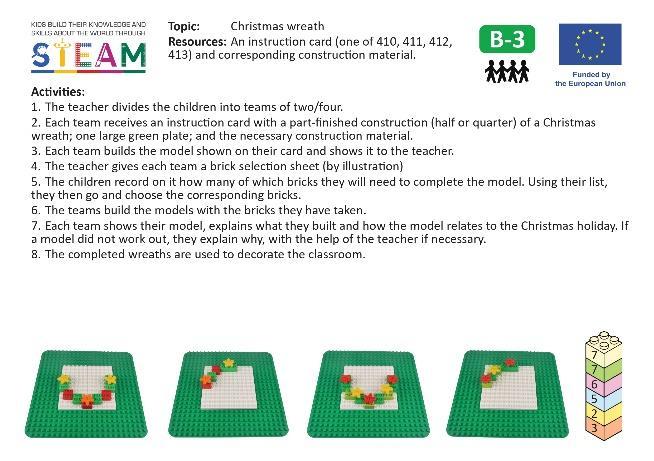
Each study card has an identifier which begins with the letter for its theme group followed by the serial numeral of the study unit in that group. For example, B-3 means that the card belongs to the "Symmetry and Composition" group and is the third in the sequence.
All teacher study cards have the following parts:
- Topic: (The subject of the project to be worked on is shown here.)
- Resources: (The resources needed to work on the topic are listed here. By resources we mean both the LEGO DUPLO construction material and any additional materials that the children need.)
- Sequence of activities: (Each step in the activities that should be undertaken with the children when working on the topic are listed here.)
- Number of children in a team: shown human figure silhouettes.
- The six STEAM components: their integration in the individual activities.
The full list of Teacher Study Cards may be found in the Teacher Cards app
Support materials for children include:
- Instruction cards
- Activity cards
- Selection sheets
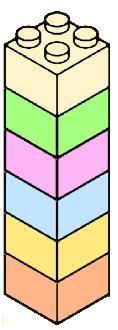
OBSERVATION

9
QUESTIONS
ANALYSIS
HYPOTHESIS EXPERIMENT
CONCLUSION
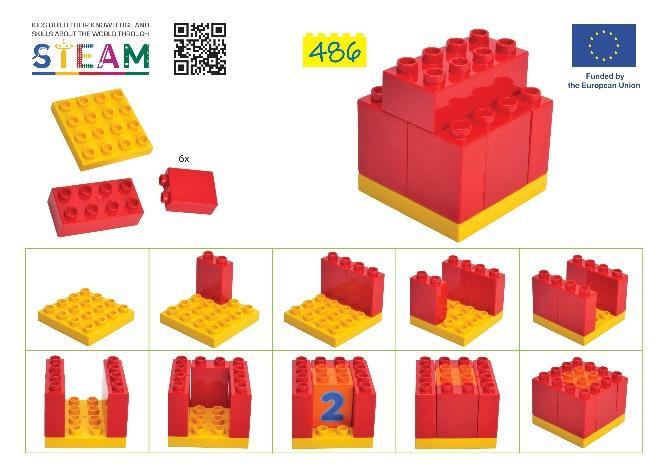
The instruction cards present, using a series of photographs, the set of construction elements required, the steps in constructing a given model, and the completed model. They are numbered starting from 410 and ending at 500. The complete list of instruction cards can be found in the Instruction Cards App. Note: the numbering is a continuation of that of the instruction cards from the project "Learning by construction in kindergarten" under the Erasmus+ program, Key activity 2, with reg. number 2020-1-BG01-KA201-079184. More information about the project can be seen on its web portal at: legoduplokids.eu.
Some instruction cards have a QR code that leads to a YouTube video. This illustrates the sequence of steps to be taken in building the model. The video may be paused at each step. The clip may be used instead of the paper version of the instruction card. This is convenient when working on the same pattern with the whole class. If there are enough tablets for each group, the teacher may load tablets with the models for each team. The teams can then go through the steps to build it themselves.
In addition, there are cards that omit the construct steps and only show the completed model. With these cards, children are expected to show more imagination and initiative, and/or to work out the steps in building the model for themselves based on their experience in working with LEGO DUPLO.
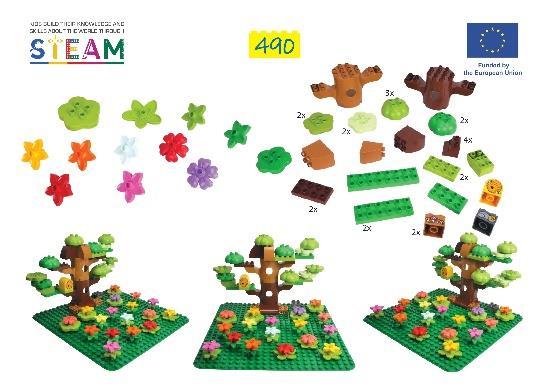
Activity cards are worksheets on which children write as they complete the project. On them, they record their hypotheses and results of their experiments. Each activity card is identified by its unit letter followed by its serial number. For example, card G-1-1 is the first activity card in unit of study G-1. Most learning units have only one activity card.
Depending on the nature of the experiment in the learning unit, activity cards are either completed individually by each child or together by all the children in a team. For example, G-1-1: the children complete the card as a team. They first identify which of the three situations they will experiment with. Then, in the yellow field, they note direction in which they think the figures will rotate when the numeral block is turned in the direction indicated. They then conduct the
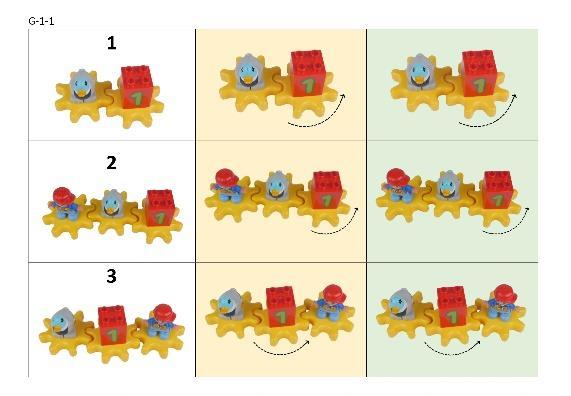
10
experiment and draw an arrow in the green field to show the directions in which the figures have rotated. They compare the directions recorded in the yellow and green fields and draw the appropriate conclusions.
Activity cards are printed in color in quantities corresponding to the number of children/teams. On the teacher resource card is indicated the colors of pencils they should have to complete the card. A full list of activity cards can be seen on the Activity Cards app.
The selecation sheets are illustrated tables on which the children/teams record what type and number of LEGO DUPLO bricks they need to build a model. They are used when the instruction card shows a model but not the steps to build it, or doesn't give all the parts needed to complete it. These sheets are used by children to plan the construction material needed to build/finish the model.


For example, In Unit B-3, children build part of a Christmas wreath using instruction card 410 and the construction material shown on it. Their task is to complete it. On selection card number 3 they record in advance the type, color and quantity of bricks they need to do finish it. Quantity is recorded by putting, next to the brick illustration, the corresponding number of dots/dashes or other sign that the teacher sets. After the inventory is filled, a team member takes it to the teacher to get the parts needed. The teacher gives the child the parts in their inventory and they return to the team to complete the model. If the team has accurately identified the parts needed, the model will be completed in full.
Selection sheets are numbered from 1 to 7. All may be found in the Selection Sheets app.
11
Assessment strategies
This section describes appropriate strategies for evaluating the results of children of using the STEAM approach with LEGO DUPLO construction material.
Formative assessment strategies are necessary to monitor and report children's progress and understanding of STEAM concepts, especially when they engage in constructive activities with LEGO DUPLO. These strategies can be both informal and structured, providing continuous feedback that informs whether the applied teaching approaches support children's learning. Here are some possibilities:
Observational assessments
Children can be observed as they engage in activities with LEGO DUPLO, noting their approach to problem solving, their ability to follow instructions, their creativity and cooperation with peers. For this purpose, a checklist related to a specific learning objective or individual notes can be used to document observations. (See Observation Card).
Self-assessment and reflection
After completing an activity with LEGO DUPLO, children can self-assess what they have achieved. For this purpose, the teacher should ask questions like:
- Do you think you have completed the task successfully?
- What was the most difficult part of building your structure?
- How did you solve a problem you faced?
This promotes self-evaluation and critical thinking and builds skills for analyzing one's own actions.
Peer feedback
After working on a task, children can present their LEGO DUPLO creations to other children and receive constructive feedback. This not only promotes communication skills, but also allows children to learn from others' approaches and solutions.
Drawings
Once a project has been completed, children may be asked to make a quick sketch of their product. What is shown and what is omitted gives an idea of what the child or team understood about the task they have just undertaken, whilst it is in front of them. Drawing is a childhood communication system that parallels language. It can provide valuable feedback on children's perceptions.
Photographic records
Taking pictures at different stages of the LEGO DUPLO model building process helps during discussions with the children to talk about the challenges encountered and how they were overcome. This visual documentation is a powerful tool for assessing progress and understanding that can be analyzed by teachers themselves and shared with parents. When making the photographic material, it is important to take pictures of the object from different points of view, in order to get a complete picture of its essence. Using a 360 degree camera is a good solution for documenting what the children have created.
Set tasks
Creating specific challenges or tasks related to STEAM concepts that children have to solve with the help of LEGO DUPLO can contribute to assessing their abilities in this direction.
12
Evaluation of their performance should be based on criteria such as credibility, functionality, creativity and application of STEAM principles. This can be done individually or in groups.
Questions and interviews
Children can be involved in individual or group discussions about their projects with LEGO DUPLO. It is recommended that open-ended questions are used, which require them to explain their actions, the scientific or mathematical concepts involved in the project, the choice made, the functionality, design and placement of the objects they have constructed.
Portfolio
Collecting photographic and video footage of children's work and assessments of task performance in a portfolio helps to document, systematise and show growth achieved over time. Portfolios can be reviewed with the child and their parents to discuss progress and outline a perspective for further development.
Digital tools
Using various digital tools or apps, children's explanations related to their LEGO DUPLO projects can be recorded. The teacher can record short videos where they explain what they have created. These clips can then be reviewed to assess comprehension and communication skills.
By using a variety of formative assessment tools and approaches, teachers can gain a comprehensive overview and understanding of each child's learning challenges and progress resulting from embedding STEAM concepts in constructive play with LEGO DUPLO. This approach to systematic assessment enables the adjustment of teaching strategies to better meet the needs of each child.
13
Teacher training
This section presents the training course created within the project for teachers to work with its methodology in the kindergarten.
The teacher training course developed for the project is a seven-day program aimed at teachers from kindergartens, primary schools, as well as heads of educational institutions and other pedagogical specialists. Its goal is to enrich educational professionals’ capabilities with methods and practices for integrating STEAM (Science, Technology, Engineering, Arts, Mathematics) concepts into the educational process through manipulative construction activities using materials such as LEGO DUPLO
The program includes a variety of modules in a number of themes. Each theme designed to support participants in developing STEAM activities that promote creativity, problem solving and an interdisciplinary approach to learning. Topics include ecology, entrepreneurship, light and shadow, balancing mechanisms, acceleration, distance control, and coding.
The course emphasizes the development of participants' skills in conducting engaging, interactive and educationally stimulating workshops.
Course syllabus for each day:
Day 1 – Introduction to STEAM
• STEAM: What is it? – Key components in STEAM (Science, Technology, Engineering, Arts, Mathematics).
• How does STEAM operate? – six basic steps: observation, questions, hypothesis, experiment, analysis, conclusions.
• Learning by research and Learning by doing – what is the difference?
• Examples of STEAM in kindergarten.
• Workshop: Research on STEAM activities in kindergarten.
Day 2 – Constructional activities in the kindergarten
• Construction as an activity in kindergarten
• Materials for constructional activities in kindergarten.
• LEGO DUPLO and other compatible construction materials.
• Examples of constructional activities in kindergarten
• Workshop: Constructiion activities using marshmallows and sticks, cups, paper, ‘junk’ and other available materials.
Day 3 – STEAM in Kindergarten using LEGO DUPLO
• Methodology for using the STEAM approach with LEGO DUPLO in the education of children.
• Teaching materials for use with the methodology - for teachers, for children.
• LEGO DUPLO and other construction sets used in the learning units
• Learning group A: Planning and construction - learning units and activities
• Learning group B: Symmetry and composition - learning units and activities
• Workshop: STEAM activities using Group A and B learning units.
14
Day 4 – Ecology, Entrepreneurship, Light and Shadows with STEAM and LEGO DUPLO for children
• Learning group C: Ecology and Entrepreneurship - study units and activities
• Learning group D: Light and Shadows - learning units and activities
• Workshop: STEAM activities using Group C and D learning units.
Day 5 - Probability, Weights, Balance, Mechanisms with STEAM and LEGO DUPLO for children
• Learning group E: Probability - learning units and activities
• Learning group F: Mass and Balance - learning units and activities.
• Learning group G: Mechanisms - learning units and activities.
• Work workshop: STEAM activities using learning units of group E, F and G.
Day 6 - Acceleration, Distance, Control and Steering with STEAM and LEGO DUPLO for children
• Learning group H: Acceleration and Distance- learning units and activities.
• Learning group I: Control and Operations - learning units and activities.
• Work workshop: STEAM activities using learning units of group H and I
Day 7 – Coding with STEAM and LEGO DUPLO for children
• Learning group J: Coding - learning units and activities.
• Work workshop: STEAM activities using learning units of group J
• Evaluation of STEAM activities using LEGO DUPLO in kindergarten.
• Workshop: Developing a STEAM activity using LEGO DUPLO.
• How do we integrate the STEAM methodology with constructional activities in kindergarten?
15
List of resources
This section presents a list of recommended LEGO DUPLO construction sets and other materials necessary for working with the learning units.
LEGO® DUPLO® 10980
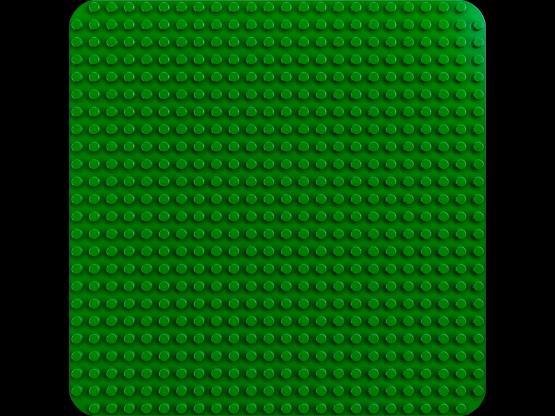
LEGO® DUPLO® 10981

LEGO® DUPLO® 10994

LEGO® DUPLO® 10982

LEGO® DUPLO® 10983

LEGO® DUPLO® 10975

16
LEGO® DUPLO® 10972
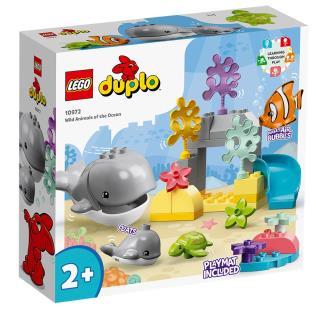
LEGO® DUPLO® 10909
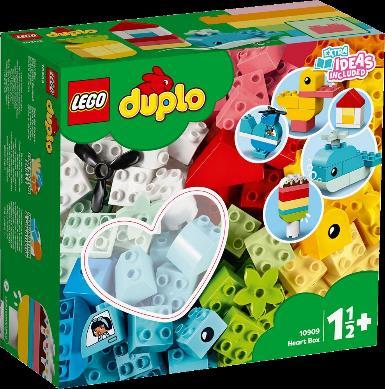
LEGO® DUPLO® 10872

LEGO® DUPLO® 10875
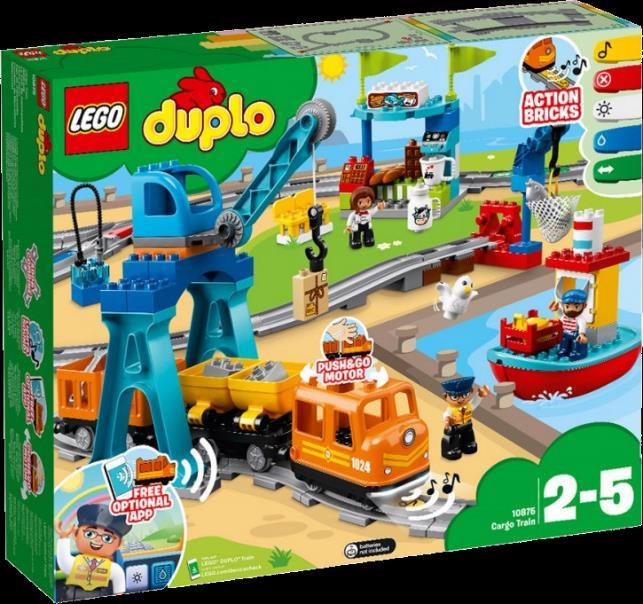
LEGO® DUPLO® 10954

DUPLO® 10914

LEGO® DUPLO® 10882

DUPLO® 10874

17
LEGO®
LEGO®
LEGO® DUPLO® 10416

LEGO® DUPLO® 10949

LEGO® DUPLO® 10419

LEGO® DUPLO® 10423
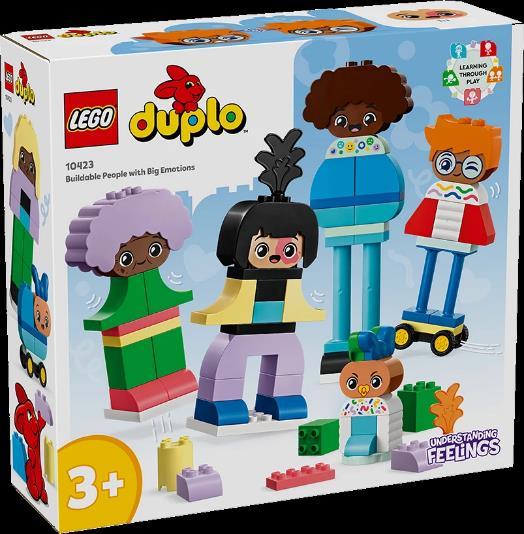
LEGO® DUPLO® 10909

LEGO® DUPLO® 10913
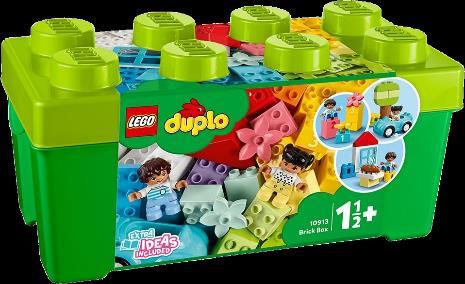
LEGO® DUPLO® 10421

LEGO® DUPLO® 10412

18
LEGO® DUPLO® 10415

LEGO® Education 45030 – People
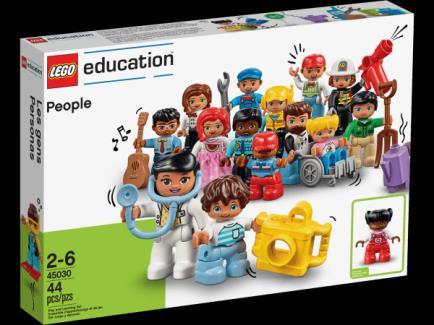
LEGO® Education 45018 - Build Me "Emotions"
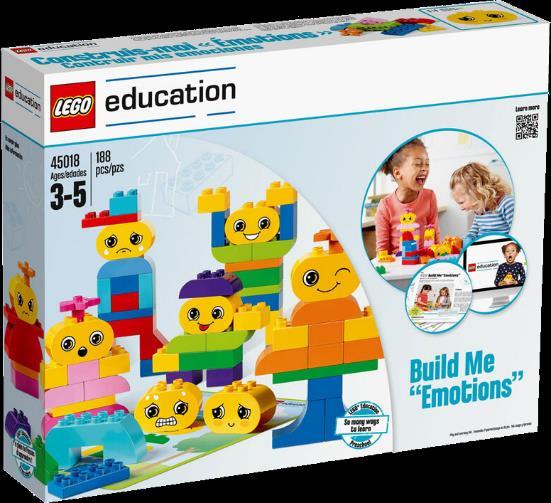
LEGO® DUPLO® 10956
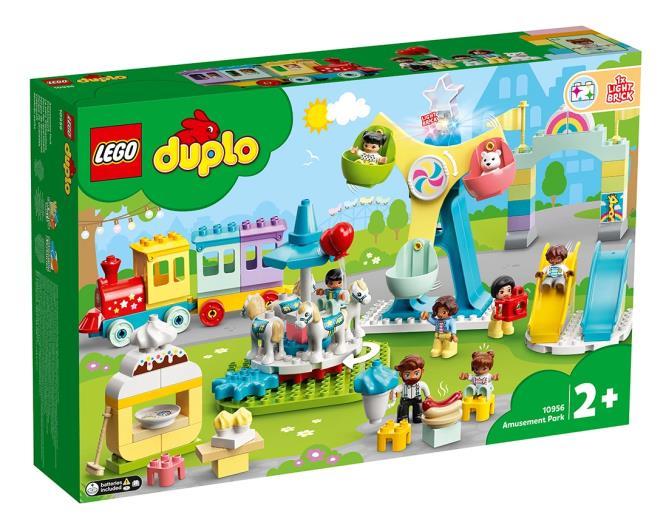
LEGO® Education 45029 – Animals

DUPLO® 10993


https://www.hubelino.com/product/marble-set/
19
LEGO®
Marble Set (one-tone)
Working conditions and safety
This section describes organizational recommendations for successful working with the project and the protection of the construction material. It is commended for establishment in the kindergarten.
The successful implementation of the proposed methodology includes a series of steps that the teacher needs to undertake:
1. Preparation for work on the topic:
• choosing a topic suitable for the age group to be worked with;
• familiarization with the study card for the subject. All study cards are available in different language versions on the Internet at: legoduplosteam.eu;
• familiarization with additional information on the topic - videos on YouTube, photographic material from the work of colleagues.
2. Preparation of resources for work according to the number of children in the group:
• providing the necessary support materials for the children. Depending on the chosen topic, these could be instruction cards (hard copy or as a projection), activity cards, block description sheets, pencils, etc.;
• distribution, in separate containers, of the construction and additional materials for each team;
• organizing workplaces for teamwork.
3. Implementation of the activities planned for the topic and formulation of conclusions from the experiment.
4. Dismantling the models by the children after the lesson.
5. Return of the construction material to the storage containers, according to the type of brick.
The construction material for all groups is stored in a designated place in the kindergarten and is used by all pedagogical specialists. The parts are stored in separate containers according to their type and purpose. The arrangement is permanent and is respected by all who use these materials. At the end of the lesson, each teacher must return the containers with correctly arranged bricks back to the storage area.
In order to ensure that the LEGO DUPLO construction material has a long life in the kindergarten, it is recommended to observe some basic practices:
Keep it clean: Regularly clean LEGO DUPLO parts with mild soap and warm water to prevent the build-up of germs and dirt. Avoid using aggressive cleaning agents that can damage the material.
Storage: Store LEGO DUPLO bricks and parts in a dry and clean place to protect them from moisture and dust. Use boxes or containers with lids for ease of organization and protection. Place stickers on each container with pictures of the parts it contains. This will make it easier to find a particular part when preparing the construction material for the lesson.
Check parts: Regularly check for damaged, broken or incompatible parts. These can pose a danger to children. Damaged parts must be replaced or removed from the set. Parts that do not belong to the LEGO DUPLO system must be removed from the storage containers.
Supervise use: Make sure children know how to use LEGO DUPLO parts properly and supervise them during play. This will avoid improper use that could damage parts or injure children. When children cannot separate two parts from each other, help them.
20
Observance of these measures will help LEGO DUPLO parts to remain in good condition and have a long and productive life in the kindergarten.
21
APPLICATIONS
1. Cards for the teacher
2. Instruction cards
3. Activity cards
4. Selection sheets
5. Observation card
22








































